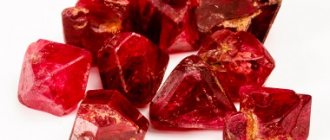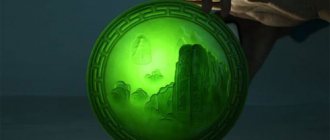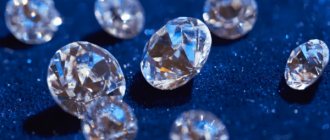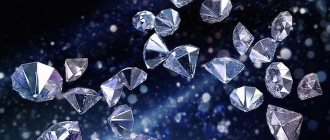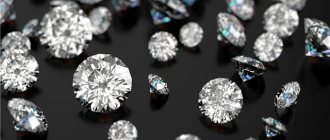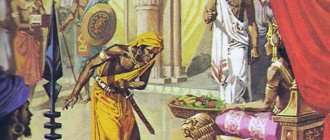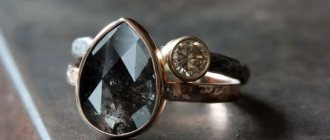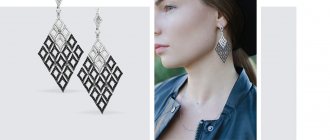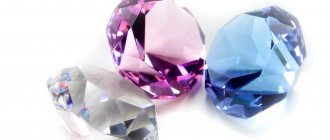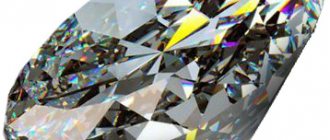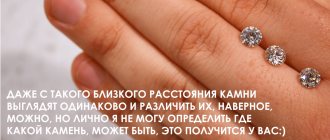Factors influencing value.
Before determining the resale value of a diamond, you should have some understanding of how such stones are valued.
Most of the factors that determine the value of an antique diamond are the same as those that influence the prices of regular diamonds: cut, color, clarity and carat weight.
In addition, an antique stone may have value as an antique.
Cut quality
Cut is a characteristic that refers to the shape of a diamond's facets, their arrangement, and their number. The proportions of the cut determine how well the stone refracts light. The more light a diamond refracts, the stronger its shine.
Antique diamonds have old-style cuts that do not enhance the brilliance of the stone as modern cuts do.
In general, the better the cut of an antique diamond enhances its brilliance and sparkle, the more valuable it will be.
While the grading system for the classic round cut is well established, there are no such strict guidelines for other cuts.
Cleanliness and condition
How clean a diamond appears is another factor that affects its price.
The fewer visible natural imperfections a stone has (such as lines or black spots), the more valuable it will be.
This characteristic is graded on a scale, and one of the most widely used grading systems is the GIA (Gemological Institute of America).
The condition of the diamond is also important. If it has external imperfections on its surface (such as chips or nicks), its quality will be reduced, resulting in a lower purity grade.
The better the condition of the diamond, as evidenced by the absence of surface defects, the higher its price will be.
Color
Color is a qualitative characteristic that is classified based on whether there are any yellow hues present in the diamond that make it appear colored.
Color is also rated on a scale, and the more colorless the stone, the higher its grade.
When judging color, it is important to see whether the stone has any visible yellow tints and how intense they are. The more colorless a diamond is, the more it is worth.
Any easily visible yellow tints in an antique diamond will reduce its value, and the stronger they are, the more its price will decrease.
Carat weight
A carat is a measure of how much a stone weighs. One carat is equal to 200 milligrams or 0.2 grams. Larger diamonds have a higher price per carat because they are difficult to find.
Conversely, the smaller your old diamond, the less it will cost, not only in absolute terms, but also per carat.
Antique value
In addition to the carat, cut, clarity and color of a diamond, its antique value can also affect its value.
For example, some collectors are willing to pay more for a diamond that was cut during a certain period of time.
Antique value, however, cannot be determined according to clearly established valuation rules. This value component varies not only from stone to stone, but also from buyer to buyer, and is assessed on a case-by-case basis.
Calculation of the cost of diamonds
When assessing a precious stone, in particular a diamond, experts focus on the following parameters:
- color. In the international classification, colorless diamonds are designated by the letter D, they are very rare and are highly valued. Stones from categories E and F are also expensive. Stones from color categories G, H, I have a not very pronounced yellow color and are moderately priced. Next come the colors J, K, L, M with obvious yellow and brown color and reduced cost. Due to the global economic downturn, the entry into the market of substitute products such as synthetic brands. Moissanite, the natural diamond market, is stagnating and trending downward in value
- purity. Determined by the scale of refraction of sunlight and the presence of small dots. This is done at 10x magnification. The fewer foreign inclusions in a stone, the more expensive it will be when assessed.
- cut quality. Flat and poorly cut stones will reduce the value of the jewelry when appraised. Diamonds with an “exemplary” cut are valued the most – in this case, complete internal reflection is achieved.
- presence of defects. Stones with pronounced scratches, chips and other defects noticeably lose value. To carry out the examination, the sample is examined at tenfold magnification.
- presence of improvement. Technologies for improving the color and quality of stones are progressing every day, and often the latest equipment determines improvements only by indirect signs. The most common color improvement method is the HPHT (high pressure, high temperature) method and the crack filling method. Such stones have low liquidity
- synthetic diamonds and moissanites. Recently, the method of producing synthetic diamonds has become more profitable than traditional mining. In this regard, there is currently a boom in the production of synthetic diamonds, which are not inferior in characteristics to natural stones at a cost that is 3 times lower. Mussanites have long been an approximate copy of a diamond and now, with improved production technology, they look worthy of their natural counterparts, at a cost of 20-50 times less.
Our specialists evaluate gemstones in Moscow in accordance with international and Russian standards at tenfold magnification, and if a more in-depth analysis and study of the structure of a gemstone is necessary, they use modern diagnostic equipment
For diamonds not in a setting/product, a certificate or expert opinion is required.
Use of assessment and certification services.
If you do not have experience in diamond grading, it is recommended that you have your antique diamond graded by a certified jewelry appraiser who is also an expert in gemology.
The appraisal must include the exact cut, clarity and color of the stone, as well as an estimate of its value.
Not only will the document provide information that will help you determine the value of the diamond, but it will also be useful as proof of quality when you try to sell your stone.
An appraisal is simply a document that tells you what the market value of an item, in this case a diamond, is.
Although you likely won't be able to sell the diamond for its market price, an appraisal can provide proof of value that can help you argue for a higher price.
If you choose to get a grade, the document will describe the stone's clarity, color, and cut grades, just like the grading report.
You can also have your antique diamond graded by a gemological laboratory.
The grading report you receive will include information about clarity, cut, color and carat weight.
However, unlike an appraisal, a classification report does not contain an estimate of value.
You can obtain a diamond certificate, but the appraisal is more useful when the product is not just individual stones, but also a precious item containing diamonds.
Determining the total cost of such items is more complex and is best done by an expert.
Having an estimate can help you negotiate price with potential buyers.
In such cases, it is always better to have a document issued by a third party that has established the quality characteristics of your diamond.
What happens after a diamond is appraised?
All of the above assigned classes are recorded after passing the examination. The specimen being examined is assigned a unique identification number. Its “parameters” are recorded in the database of the institute or organization that conducted the assessment. Also, the assessed diamond is assigned and issued a certificate confirming its authenticity and the previously described parameters.
If a precious mineral needs, for example, to be restored, then the organization carrying out this work (if not the one that carried out the assessment) must first contact the appraisal organization and warn it about the upcoming work.
After the work is completed, the contractor should send or transfer the restored stone to the organization that carried out the first assessment. She must re-evaluate the stone, make the necessary amendments to her database and issue a new certificate with an added detailed description of the work performed. After making all the changes, the appraisal organization transfers the stone with the document back to the contractor, who then gives the restored sample to the customer.
As a rule, the procedure is significantly simplified, because this issue is often dealt with by entire jewelry houses, which can evaluate the diamond and contact other appraisal organizations to carry out the necessary restoration work.
Estimating Value: How Much Can You Get for Your Antique Diamond?
You should be aware that the price set by an appraiser for your diamond is unlikely to be equal or even close to the price you would receive if you sold it to a jeweler or diamond buyer.
In most cases, you won't get even 50% of what similar quality diamonds would sell for in a jewelry store, and often, the actual figure will be around 20% or less.
The reason for this is that stores buy new stones at wholesale prices, which are lower than retail prices. Jewelers raise prices to cover store expenses such as salaries and rent, plus some profit on top.
As you can see, jewelers have no reason to buy your antique diamond at retail price when they can get a new item for less.
If you want to get a realistic picture of how much you could get for your diamond, look for stones that are around the same carat weight, color, clarity grade and cut.
Look at the average retail price for these diamonds and assume you'll get 20% of it. (This method does not take into account the antique value your antique diamond may have.)
Overall, the actual price you can get for your diamond will depend not only on its condition, but also on where and how you sell the stone.
If you sell your diamond for cash, the price you will receive will be lower than if you exchange the stone for another piece of jewelry in a store.
And most jewelers don't buy diamonds with cash, and if they do, they usually pay less than the credit they're willing to provide.
Depending on who you sell your diamond to, you may get better or worse deals.
As a general rule, the further away the customer is from the retail outlet, the less money you are likely to receive.
This means that it is unlikely that a wholesale diamond supplier will pay more than a retail jeweler, although the latter will not necessarily pay more - you will have to ask around and try different potential buyers.
Online gemstone appraisal
So that our pawnshop clients can find out the preliminary cost of diamond jewelry, we have developed an online valuation service. This service will allow you to determine the approximate amount of jewelry redemption without leaving your home.
To use the online calculator, you must:
- indicate your name and contact phone number;
- attach photographs of jewelry;
- send the application to the appraiser.
To increase the accuracy of your online assessment, take high-resolution photographs of the product from different angles. In the comments to the application, describe in detail the hidden defects of the stones, if they are not visible in the photo.
After a short time, an expert will contact you and announce the approximate price of jewelry with precious stones. To find out the exact cost of a piece of jewelry, you need to contact one of our pawnshop branches in Moscow.
Trade-in: Is this really the best deal?
An alternative to selling an antique diamond for cash is to exchange it for a new piece of jewelry. The jeweler will give you a trade-in price that you will not receive in cash, but will be able to use to purchase another item from the store.
In this case, you will usually have to pay a little extra to cover the difference between the exchange value and the retail price of the new item. This arrangement is usually more profitable than a cash sale. Jewelers will be willing to offer you the best trade-in price for your diamond since you make a new purchase from their store.
So if you're choosing between trading and selling for cash, the former will usually be the better option.

